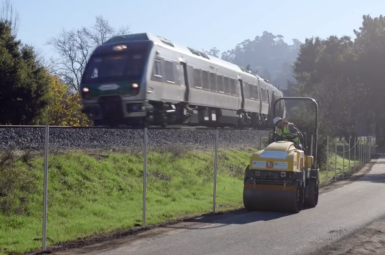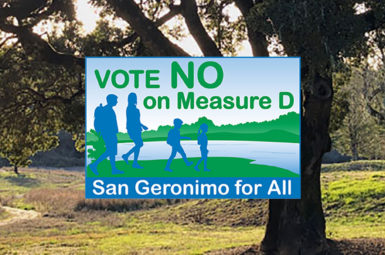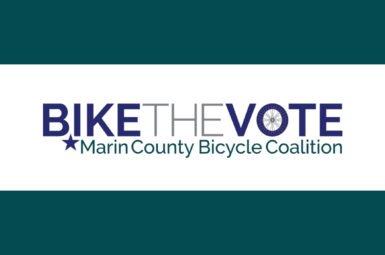March 2020 Election Board of Supervisors Candidate Questionnaire
As a 501(c)3 nonprofit organization, Marin County Bicycle Coalition cannot endorse candidates for public office, but we are able to share information so that you can arrive at your own conclusion. Below are Board of Supervisors candidates’ responses to our questionnaire on bicycling in Marin. We have made no content changes. Thanks to the candidates for their time and thoughtful answers!
Here are the candidates on the March 3 ballot for Board of Supervisors:
-
District 2: Katie Rice
-
District 3: Bill Bailey, Jack Kenney, Stephanie Moulton-Peters
-
District 4: Dennis Rodoni, Alex Easton-Brown
In District 3, we have not been able to get in touch with Jack Kenney; Bill Bailey has not responded.
In District 4, Dennis Rodoni has not responded.
Do you ride a bicycle? If so, for what purposes? (transportation/road/mtb)
Katie Rice (District 2): Yes – Transportation, MTB
Stephanie Moulton-Peters (District 3): Yes – Transportation, Road, MTB
Alex Easton-Brown (District 4): Yes – Road
Do you support the completion of the North-South Greenway, a continuous pathway following the former Northwestern Pacific Railroad alignment (including Alto Tunnel) from Sausalito to Novato?
Katie Rice (District 2): Yes
Stephanie Moulton-Peters (District 3): Yes
Alex Easton-Brown (District 4): Yes
Would you support the adoption of a Countywide Vision Zero policy and corresponding enforcement, education, and engineering initiatives aimed at eliminating all traffic fatalities and severe injuries? (yes/no/other)
Katie Rice (District 2): Yes
Stephanie Moulton-Peters (District 3): Yes
Alex Easton-Brown (District 4): Yes
Do you support the creation of purpose-built mountain biking trails, open to bikes only, on public lands in order to reduce trail conflicts and expand access? (Yes/no/other)
Katie Rice (District 2): Other (see below)
Not sure if this means creation of new trails, or conversion of existing; would need more info on concept and any specific proposals.
Stephanie Moulton-Peters (District 3): Yes
Alex Easton-Brown (District 4): Yes
Do you support the allowance of e-MTBs on fire roads or multi-use trails in Marin County Parks and Open Space Preserves?
Katie Rice (District 2): Other (see below)
I’m open to considering Class 1 e-MTB on fire roads and multi-use trails.
Stephanie Moulton-Peters (District 3): Other (see below)
I would support a pilot test of e-MTBs on selected trails to test access and impacts and then develop policies regarding use, education and enforcement, and trails appropriate for e-MTBs.
Alex Easton-Brown (District 4): Yes
Please rate the following statements on a scale of 1 (Strongly Disagree) to 5 (Strongly Agree)
Bicycling has the potential to significantly reduce traffic congestion and greenhouse gas emissions from transportation in Marin.
Katie Rice (District 2): 4 – Agree
Stephanie Moulton-Peters (District 3): 4 – Agree
Alex Easton-Brown (District 4): 5 – Strongly Agree
Agencies in Marin should do more to invest in and prioritize active transportation (walking/bicycling).
Katie Rice (District 2): 5 – Strongly Agree
Stephanie Moulton-Peters (District 3): 4 – Agree
Alex Easton-Brown (District 4): 5 – Strongly Agree
Land managers in Marin should do more to improve trail access for mountain biking.
Katie Rice (District 2): 3 – Do Not Agree or Disagree
Stephanie Moulton-Peters (District 3): 4 – Agree
Alex Easton-Brown (District 4): 5 – Strongly Agree
If elected, what would you do to 1) improve safety for people riding bikes in your jurisdiction and 2) increase the number of people who bike?
Katie Rice (District 2):
In my district we are seeing an explosion of folks making the transition from car to bike for every day local trips (work, school, errands, pick-ups, drop-offs) using “class 2” routes where existing, but as often class 3 (barely) and having to share the road and inadequate shoulders even when choosing lower volume streets. We can do better and we can do more, to make it safer for those currently riding and the explosion of bike riders to come.
Funding is key to making improvements, but as, if not more important is the strength and follow-thru of policy directive. Towards providing a strong policy backbone to bike-friendly communities, I’d like to see the county and all communities adopt/get behind Vision Zero. Adoption of vision zero would support policy decisions that prioritize bike/ped safety.
Bottom line: 1) We need to increase and accelerate investment within our local communities towards developing/fleshing out intra and inter-community primary east/west, north/south routes to support growing population of folks (all ages). And 2) we need to invest in (marketing, education, campaigns?) towards developing a community culture that is respectful of all modes of travel, making it safer for all modes.
Stephanie Moulton-Peters (District 3):
Through my twenty years’ work with Mill Valley’s Safe Routes to School Task Force and my advocacy to create the Mill Valley Bicycle and Pedestrian Advisory Committee (BPAC), I have actively advocated for education, enforcement and infrastructure improvements to make Mill Valley’s streets safer for cyclists of all ages. Due to these efforts, In 2018 Mill Valley earned 3 Statewide Awards for “Best Local Street” for Miller Ave, our multi modal corridor, and also earned the Bike Friendly Cities “Silver Award” from the League of American Bicyclists, making Mill Valley the first city in Marin to achieve this award. By the end of 2020 Mill Valley will have buffered Class 2 bicycle lanes on all arterials that can accommodate them, and Class 3 facilities on remaining segments. I am committed to developing a bicycle network connecting Southern Marin cities and towns, including over Hwy 101.
MCBC’s advocacy for separated biking facilities, Safe Routes, and Share the Road education have contributed greatly to the safety of cyclists in Marin. Recently, I’ve been in conversation with MCBC staff about additional safety education opportunities. I believe there are also initiatives and promotions that neighboring Bay Area counties have undertaken that Marin has not yet embraced. We can learn from our neighbors; I intend to develop the relationships I have with Supervisors in adjacent counties, to learn what efforts have successfully grown their cycling community and led to safer riding conditions, and to pilot those ideas in Marin in partnership with MCBC.
Alex Easton-Brown (District 4):
Dedicated Bike Paths. Bike storage shelters.
What’s your vision for the future of transportation in Marin?
Katie Rice (District 2):
Though our topography and development pattern (and density) very different than Copenhagen’s, it doesn’t mean we can’t aspire to be as multi-modal friendly and as multi-modal safe. This will mean making a committment to making our communities as bike-able, walkable, etc. for local trips and first/last mile. And having a robust system/environment of viable, sustainable, practical transit options for folks who can’t drive, or choose not to. (A growing senior population is going to make this imperative.)
Stephanie Moulton-Peters (District 3):
My vision for the future of transportation in Marin is: multi modal, green and connected! My vision is rooted in the extensive community process that envisioned a multimodal transportation future for Marin and led to the 2004 passage of the Measure A half-cent sales tax. The Measure provided funding for bicycle and pedestrian improvements, including the North-South Greenway, along with local transit, streets and roads, and highway connections.
In 2018 as Board Chair of the Transportation Authority of Marin, I led the successful 30 year renewal of the transportation sales tax, Measure AA, that not only continues to fund our multi modal future, but also added new, “green” dimensions to our transportation future to reduce transportation-related greenhouse gases, the largest source of Marin’s GHGs, contributing to climate change and sea level rise.
Measure AA provides funds for a future of electric transit buses, construction of electric vehicle charging stations; encourages the lease or purchase of electric vehicles through Drive Clean Marin initiative; and incentivizes the use of transit alternatives through the Marin Commutes program that promotes cycling, bike and car share, and ride-share for local trips and “first-last mile” connections to the San Rafael Transit Center and to Ferry and SMART Stations. I envision these as future “green transit hubs” and, as an e-bike and soon-to-be e-V owner, will make these priorities.
Importantly, I will continue the hard work to complete the East-West Corridor and the North-South Greenway for bicycles to offer Marin residents safe, healthy travel alternatives; these are critical elements of Marin’s transportation future.
Alex Easton-Brown (District 4):
Less dependence on the automobile.
What’s your vision for the future of access and recreational opportunities across Marin’s public lands?
Katie Rice (District 2):
Marin’s public lands are what make this place so special. Our open space and access to view, recreate, share it with others is what brought us to Marin, keeps us here, and draws others to visit, explore, recreate across Marin’s public lands.
Nearly all our public lands were protected with two primary objectives in mind — environmental/natural resource protection and preservation as open space for public use and enjoyment (versus private development) (And in the case of MMWD for protection of watershed for local water source.)
Marin’s population is likely to experience slow, incremental growth at best, but the broader Bay Area will continue to expand. In 1972 the population of the nine county Bay Area was 2 million, today it is over 7 million. Hence the increasing demand/use throughout Marin’s public lands (across land owners). And over the last five decades, recreation preferences have evolved as well.
My vision for Marin’s public lands is that we continue to honor the promise made when these lands were saved — a commitment to environmental/natural resource protection and public access and enjoyment — regardless of growing demand, or changes in user mix or recreational options.
Stephanie Moulton-Peters (District 3):
Marin County is blessed with an abundance of open space and opportunities for walking, running hiking, biking and horseback riding – and jurisdictions throughout the county are working to open even more open spaces for public use. In addition to our County parks and open spaces, Muir Woods National Monument, Golden Gate National Recreation Area, and Mt Tamalpias State Park, beckon visitors from the Bay Area, the country, and around the world.
With multiple uses and visitors from near and far comes the opportunity for conflicts among users, overuse of recreational assets, weekend visitor traffic and congestion, and other unintended consequences. Our greatest natural assets also provide some of our greatest challenges in terms of managing use in a way that is fair and equitable, while promoting safety and enjoyment for users and protections for the natural environment.
Balancing these interests takes dialogue among user groups, and time and effort to develop usage strategies, to pilot test and refine these strategies, apply them where they are appropriate, and monitor and make changes as needed. I believe MCBC has done a good job in fostering the dialogues, education and outreach with user groups resulting in efforts such as “Slow and Say Hello”. I also believe that separated trails for slower and faster moving users, opening new trails in some, lesser used County parks and open spaces, and encouraging their use by visitors are means to a positive future for access and recreational use across Marin’s Public Lands.
Alex Easton-Brown (District 4):
Integrated Bike Paths and Access.
candidate websites
-
District 2: Katie Rice
-
District 3: Bill Bailey (no known website) | Jack Kenney (no known website) | Stephanie Moulton-Peters
-
District 4: Dennis Rodoni | Alex Easton-Brown



